Financial Statements: Accounting Concepts and Characteristics
VerifiedAdded on 2023/06/18
|8
|1481
|463
Report
AI Summary
This report provides a comprehensive overview of accounting concepts and the qualitative characteristics of financial reports. It begins by defining accounting and its importance in business. The report then delves into five key accounting concepts: the accrual principle, which emphasizes recognizing income and costs when earned or incurred; the conservatism principle, focused on accuracy by understating earnings and assets; the consistency principle, promoting the use of uniform accounting methods; the cost principle, which dictates recording assets at their historical cost; and the economic entity principle, which separates business transactions from the owner's personal finances. Furthermore, the report discusses the qualitative characteristics that make financial reports useful, including understandability, comparability, timeliness, and faithful representation. Each characteristic is explained with examples to illustrate their significance in providing reliable and relevant financial information to both internal and external stakeholders. This document is available on Desklib, a platform offering a range of study tools and solved assignments for students.

Accounting for Business
Paraphrase This Document
Need a fresh take? Get an instant paraphrase of this document with our AI Paraphraser

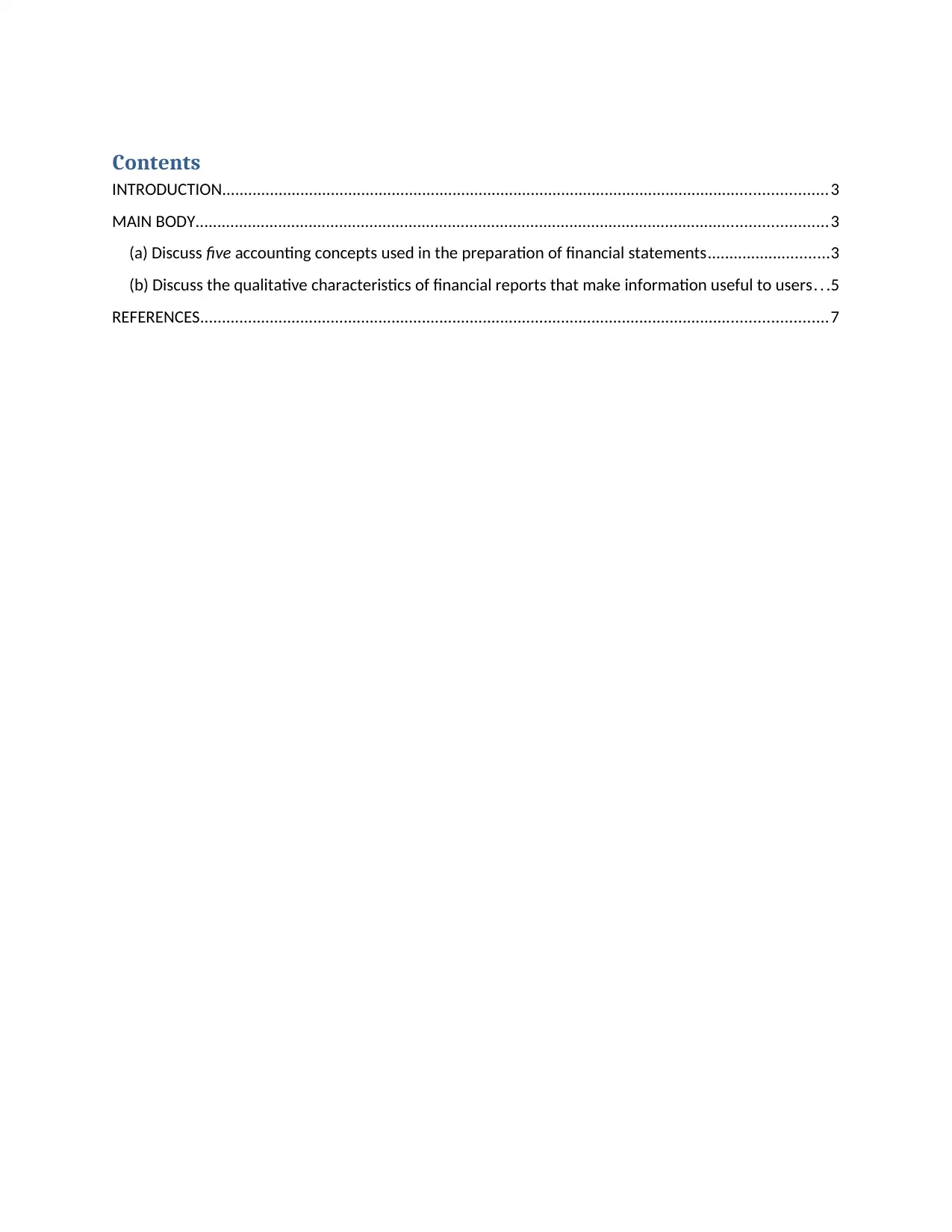
Contents
INTRODUCTION...........................................................................................................................................3
MAIN BODY.................................................................................................................................................3
(a) Discuss five accounting concepts used in the preparation of financial statements............................3
(b) Discuss the qualitative characteristics of financial reports that make information useful to users. . .5
REFERENCES................................................................................................................................................7
INTRODUCTION...........................................................................................................................................3
MAIN BODY.................................................................................................................................................3
(a) Discuss five accounting concepts used in the preparation of financial statements............................3
(b) Discuss the qualitative characteristics of financial reports that make information useful to users. . .5
REFERENCES................................................................................................................................................7
⊘ This is a preview!⊘
Do you want full access?
Subscribe today to unlock all pages.

Trusted by 1+ million students worldwide
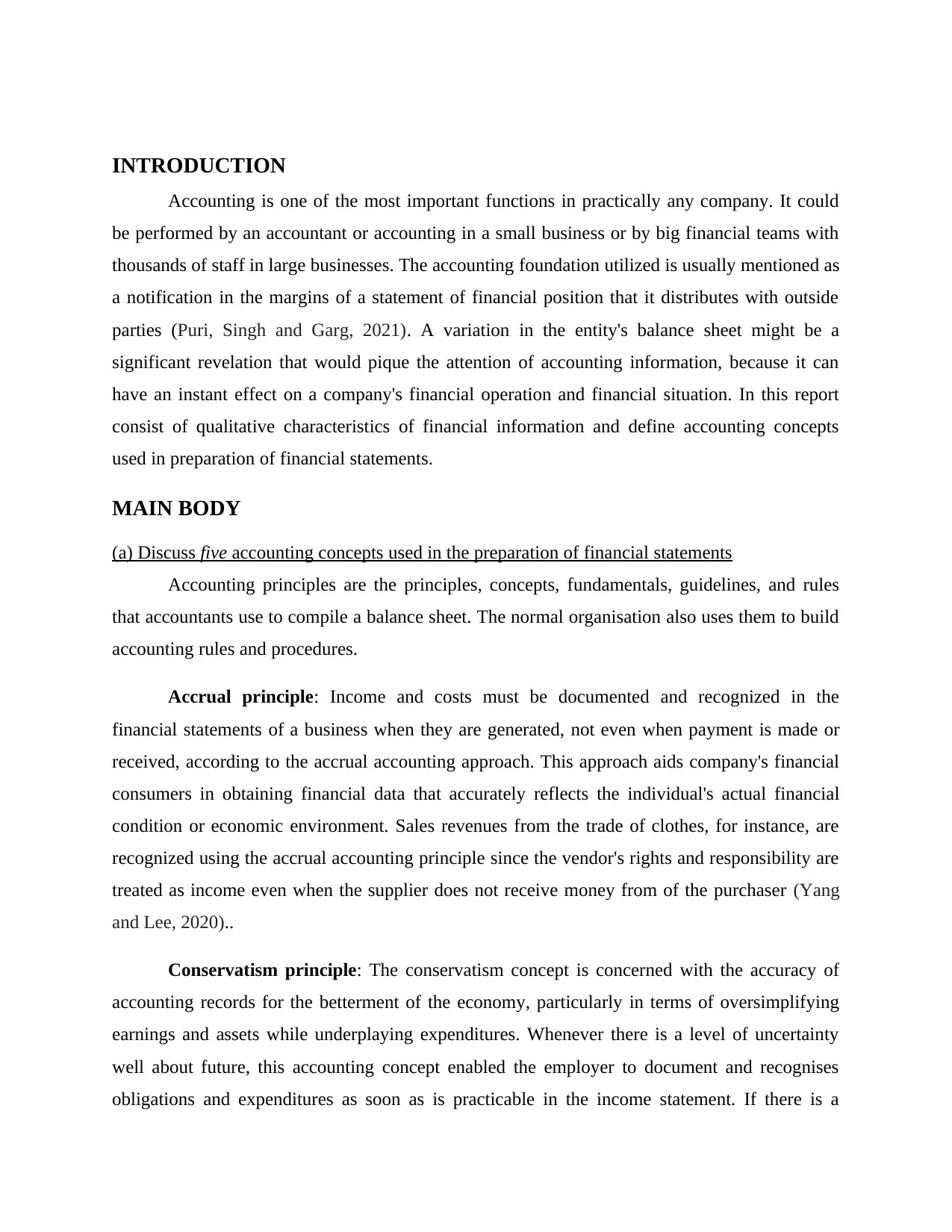
INTRODUCTION
Accounting is one of the most important functions in practically any company. It could
be performed by an accountant or accounting in a small business or by big financial teams with
thousands of staff in large businesses. The accounting foundation utilized is usually mentioned as
a notification in the margins of a statement of financial position that it distributes with outside
parties (Puri, Singh and Garg, 2021). A variation in the entity's balance sheet might be a
significant revelation that would pique the attention of accounting information, because it can
have an instant effect on a company's financial operation and financial situation. In this report
consist of qualitative characteristics of financial information and define accounting concepts
used in preparation of financial statements.
MAIN BODY
(a) Discuss five accounting concepts used in the preparation of financial statements
Accounting principles are the principles, concepts, fundamentals, guidelines, and rules
that accountants use to compile a balance sheet. The normal organisation also uses them to build
accounting rules and procedures.
Accrual principle: Income and costs must be documented and recognized in the
financial statements of a business when they are generated, not even when payment is made or
received, according to the accrual accounting approach. This approach aids company's financial
consumers in obtaining financial data that accurately reflects the individual's actual financial
condition or economic environment. Sales revenues from the trade of clothes, for instance, are
recognized using the accrual accounting principle since the vendor's rights and responsibility are
treated as income even when the supplier does not receive money from of the purchaser (Yang
and Lee, 2020)..
Conservatism principle: The conservatism concept is concerned with the accuracy of
accounting records for the betterment of the economy, particularly in terms of oversimplifying
earnings and assets while underplaying expenditures. Whenever there is a level of uncertainty
well about future, this accounting concept enabled the employer to document and recognises
obligations and expenditures as soon as is practicable in the income statement. If there is a
Accounting is one of the most important functions in practically any company. It could
be performed by an accountant or accounting in a small business or by big financial teams with
thousands of staff in large businesses. The accounting foundation utilized is usually mentioned as
a notification in the margins of a statement of financial position that it distributes with outside
parties (Puri, Singh and Garg, 2021). A variation in the entity's balance sheet might be a
significant revelation that would pique the attention of accounting information, because it can
have an instant effect on a company's financial operation and financial situation. In this report
consist of qualitative characteristics of financial information and define accounting concepts
used in preparation of financial statements.
MAIN BODY
(a) Discuss five accounting concepts used in the preparation of financial statements
Accounting principles are the principles, concepts, fundamentals, guidelines, and rules
that accountants use to compile a balance sheet. The normal organisation also uses them to build
accounting rules and procedures.
Accrual principle: Income and costs must be documented and recognized in the
financial statements of a business when they are generated, not even when payment is made or
received, according to the accrual accounting approach. This approach aids company's financial
consumers in obtaining financial data that accurately reflects the individual's actual financial
condition or economic environment. Sales revenues from the trade of clothes, for instance, are
recognized using the accrual accounting principle since the vendor's rights and responsibility are
treated as income even when the supplier does not receive money from of the purchaser (Yang
and Lee, 2020)..
Conservatism principle: The conservatism concept is concerned with the accuracy of
accounting records for the betterment of the economy, particularly in terms of oversimplifying
earnings and assets while underplaying expenditures. Whenever there is a level of uncertainty
well about future, this accounting concept enabled the employer to document and recognises
obligations and expenditures as soon as is practicable in the income statement. If there is a
Paraphrase This Document
Need a fresh take? Get an instant paraphrase of this document with our AI Paraphraser
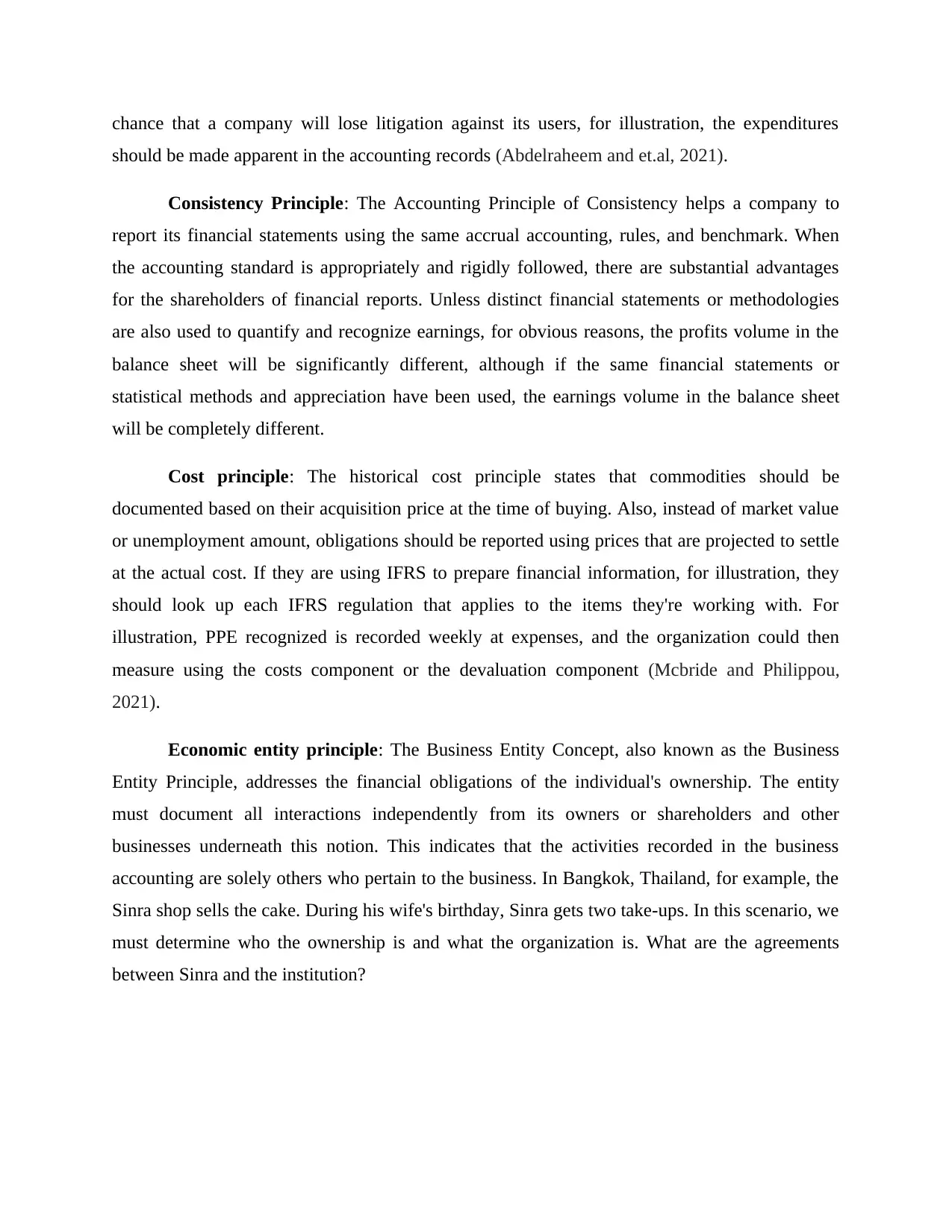
chance that a company will lose litigation against its users, for illustration, the expenditures
should be made apparent in the accounting records (Abdelraheem and et.al, 2021).
Consistency Principle: The Accounting Principle of Consistency helps a company to
report its financial statements using the same accrual accounting, rules, and benchmark. When
the accounting standard is appropriately and rigidly followed, there are substantial advantages
for the shareholders of financial reports. Unless distinct financial statements or methodologies
are also used to quantify and recognize earnings, for obvious reasons, the profits volume in the
balance sheet will be significantly different, although if the same financial statements or
statistical methods and appreciation have been used, the earnings volume in the balance sheet
will be completely different.
Cost principle: The historical cost principle states that commodities should be
documented based on their acquisition price at the time of buying. Also, instead of market value
or unemployment amount, obligations should be reported using prices that are projected to settle
at the actual cost. If they are using IFRS to prepare financial information, for illustration, they
should look up each IFRS regulation that applies to the items they're working with. For
illustration, PPE recognized is recorded weekly at expenses, and the organization could then
measure using the costs component or the devaluation component (Mcbride and Philippou,
2021).
Economic entity principle: The Business Entity Concept, also known as the Business
Entity Principle, addresses the financial obligations of the individual's ownership. The entity
must document all interactions independently from its owners or shareholders and other
businesses underneath this notion. This indicates that the activities recorded in the business
accounting are solely others who pertain to the business. In Bangkok, Thailand, for example, the
Sinra shop sells the cake. During his wife's birthday, Sinra gets two take-ups. In this scenario, we
must determine who the ownership is and what the organization is. What are the agreements
between Sinra and the institution?
should be made apparent in the accounting records (Abdelraheem and et.al, 2021).
Consistency Principle: The Accounting Principle of Consistency helps a company to
report its financial statements using the same accrual accounting, rules, and benchmark. When
the accounting standard is appropriately and rigidly followed, there are substantial advantages
for the shareholders of financial reports. Unless distinct financial statements or methodologies
are also used to quantify and recognize earnings, for obvious reasons, the profits volume in the
balance sheet will be significantly different, although if the same financial statements or
statistical methods and appreciation have been used, the earnings volume in the balance sheet
will be completely different.
Cost principle: The historical cost principle states that commodities should be
documented based on their acquisition price at the time of buying. Also, instead of market value
or unemployment amount, obligations should be reported using prices that are projected to settle
at the actual cost. If they are using IFRS to prepare financial information, for illustration, they
should look up each IFRS regulation that applies to the items they're working with. For
illustration, PPE recognized is recorded weekly at expenses, and the organization could then
measure using the costs component or the devaluation component (Mcbride and Philippou,
2021).
Economic entity principle: The Business Entity Concept, also known as the Business
Entity Principle, addresses the financial obligations of the individual's ownership. The entity
must document all interactions independently from its owners or shareholders and other
businesses underneath this notion. This indicates that the activities recorded in the business
accounting are solely others who pertain to the business. In Bangkok, Thailand, for example, the
Sinra shop sells the cake. During his wife's birthday, Sinra gets two take-ups. In this scenario, we
must determine who the ownership is and what the organization is. What are the agreements
between Sinra and the institution?
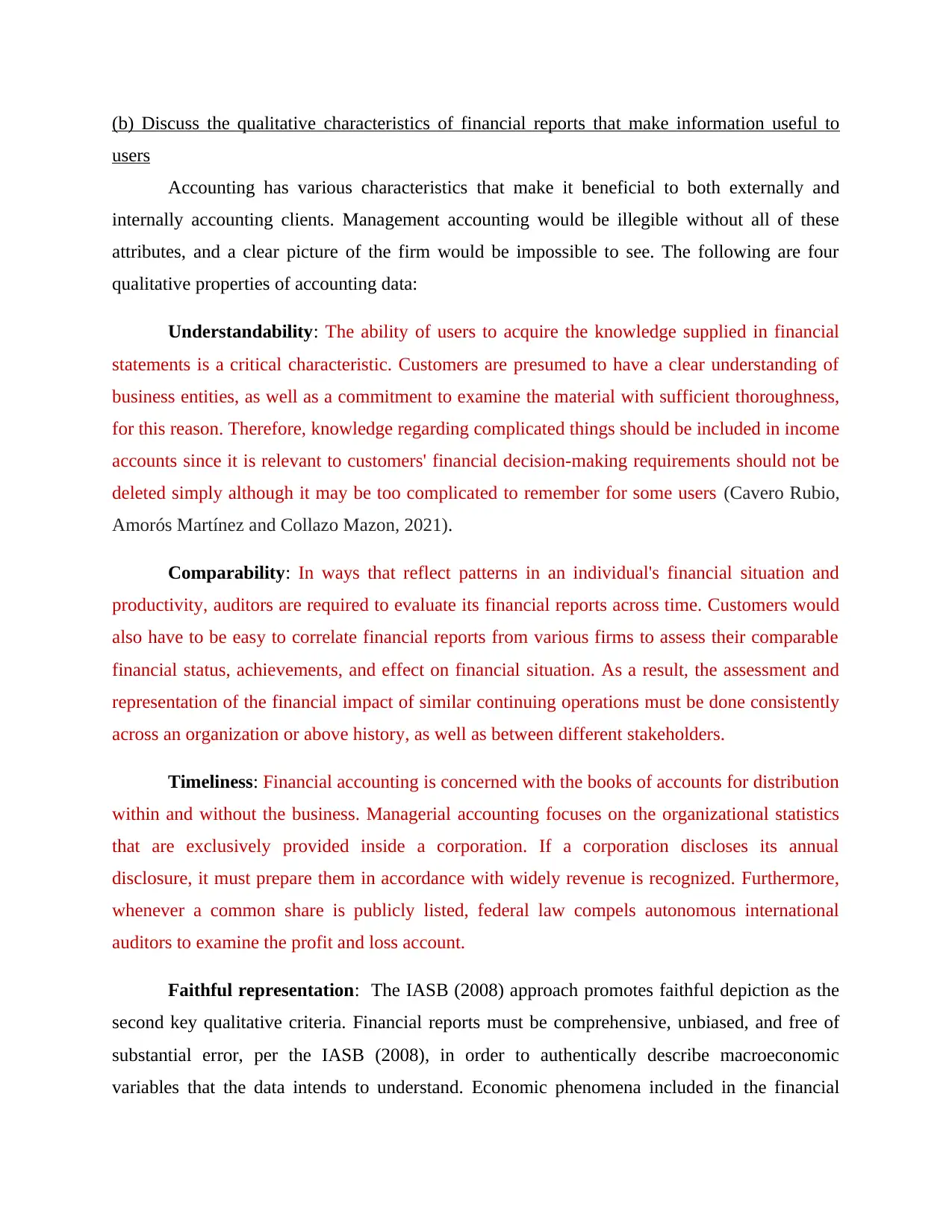
(b) Discuss the qualitative characteristics of financial reports that make information useful to
users
Accounting has various characteristics that make it beneficial to both externally and
internally accounting clients. Management accounting would be illegible without all of these
attributes, and a clear picture of the firm would be impossible to see. The following are four
qualitative properties of accounting data:
Understandability: The ability of users to acquire the knowledge supplied in financial
statements is a critical characteristic. Customers are presumed to have a clear understanding of
business entities, as well as a commitment to examine the material with sufficient thoroughness,
for this reason. Therefore, knowledge regarding complicated things should be included in income
accounts since it is relevant to customers' financial decision-making requirements should not be
deleted simply although it may be too complicated to remember for some users (Cavero Rubio,
Amorós Martínez and Collazo Mazon, 2021).
Comparability: In ways that reflect patterns in an individual's financial situation and
productivity, auditors are required to evaluate its financial reports across time. Customers would
also have to be easy to correlate financial reports from various firms to assess their comparable
financial status, achievements, and effect on financial situation. As a result, the assessment and
representation of the financial impact of similar continuing operations must be done consistently
across an organization or above history, as well as between different stakeholders.
Timeliness: Financial accounting is concerned with the books of accounts for distribution
within and without the business. Managerial accounting focuses on the organizational statistics
that are exclusively provided inside a corporation. If a corporation discloses its annual
disclosure, it must prepare them in accordance with widely revenue is recognized. Furthermore,
whenever a common share is publicly listed, federal law compels autonomous international
auditors to examine the profit and loss account.
Faithful representation: The IASB (2008) approach promotes faithful depiction as the
second key qualitative criteria. Financial reports must be comprehensive, unbiased, and free of
substantial error, per the IASB (2008), in order to authentically describe macroeconomic
variables that the data intends to understand. Economic phenomena included in the financial
users
Accounting has various characteristics that make it beneficial to both externally and
internally accounting clients. Management accounting would be illegible without all of these
attributes, and a clear picture of the firm would be impossible to see. The following are four
qualitative properties of accounting data:
Understandability: The ability of users to acquire the knowledge supplied in financial
statements is a critical characteristic. Customers are presumed to have a clear understanding of
business entities, as well as a commitment to examine the material with sufficient thoroughness,
for this reason. Therefore, knowledge regarding complicated things should be included in income
accounts since it is relevant to customers' financial decision-making requirements should not be
deleted simply although it may be too complicated to remember for some users (Cavero Rubio,
Amorós Martínez and Collazo Mazon, 2021).
Comparability: In ways that reflect patterns in an individual's financial situation and
productivity, auditors are required to evaluate its financial reports across time. Customers would
also have to be easy to correlate financial reports from various firms to assess their comparable
financial status, achievements, and effect on financial situation. As a result, the assessment and
representation of the financial impact of similar continuing operations must be done consistently
across an organization or above history, as well as between different stakeholders.
Timeliness: Financial accounting is concerned with the books of accounts for distribution
within and without the business. Managerial accounting focuses on the organizational statistics
that are exclusively provided inside a corporation. If a corporation discloses its annual
disclosure, it must prepare them in accordance with widely revenue is recognized. Furthermore,
whenever a common share is publicly listed, federal law compels autonomous international
auditors to examine the profit and loss account.
Faithful representation: The IASB (2008) approach promotes faithful depiction as the
second key qualitative criteria. Financial reports must be comprehensive, unbiased, and free of
substantial error, per the IASB (2008), in order to authentically describe macroeconomic
variables that the data intends to understand. Economic phenomena included in the financial
⊘ This is a preview!⊘
Do you want full access?
Subscribe today to unlock all pages.

Trusted by 1+ million students worldwide

statement, according to IASB (2008), are "financial value and responsibilities, as well as
activities and other activities and conditions that modify them." Impartiality, thoroughness,
independence from significant error, and repeatability are frequently used to define reliable
estimate (Dasoo, Bornman and Rhodes, 2020)
activities and other activities and conditions that modify them." Impartiality, thoroughness,
independence from significant error, and repeatability are frequently used to define reliable
estimate (Dasoo, Bornman and Rhodes, 2020)
Paraphrase This Document
Need a fresh take? Get an instant paraphrase of this document with our AI Paraphraser
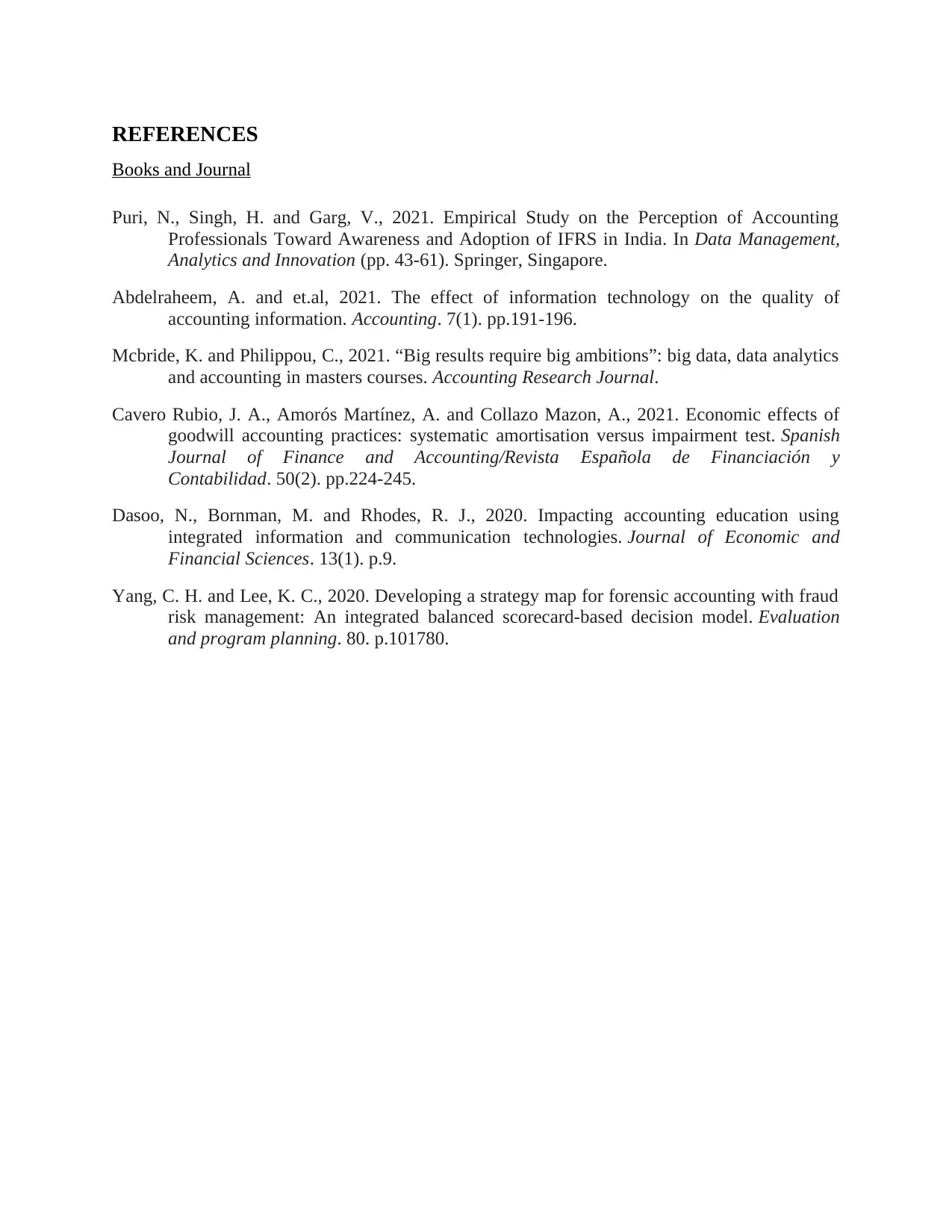
REFERENCES
Books and Journal
Puri, N., Singh, H. and Garg, V., 2021. Empirical Study on the Perception of Accounting
Professionals Toward Awareness and Adoption of IFRS in India. In Data Management,
Analytics and Innovation (pp. 43-61). Springer, Singapore.
Abdelraheem, A. and et.al, 2021. The effect of information technology on the quality of
accounting information. Accounting. 7(1). pp.191-196.
Mcbride, K. and Philippou, C., 2021. “Big results require big ambitions”: big data, data analytics
and accounting in masters courses. Accounting Research Journal.
Cavero Rubio, J. A., Amorós Martínez, A. and Collazo Mazon, A., 2021. Economic effects of
goodwill accounting practices: systematic amortisation versus impairment test. Spanish
Journal of Finance and Accounting/Revista Española de Financiación y
Contabilidad. 50(2). pp.224-245.
Dasoo, N., Bornman, M. and Rhodes, R. J., 2020. Impacting accounting education using
integrated information and communication technologies. Journal of Economic and
Financial Sciences. 13(1). p.9.
Yang, C. H. and Lee, K. C., 2020. Developing a strategy map for forensic accounting with fraud
risk management: An integrated balanced scorecard-based decision model. Evaluation
and program planning. 80. p.101780.
Books and Journal
Puri, N., Singh, H. and Garg, V., 2021. Empirical Study on the Perception of Accounting
Professionals Toward Awareness and Adoption of IFRS in India. In Data Management,
Analytics and Innovation (pp. 43-61). Springer, Singapore.
Abdelraheem, A. and et.al, 2021. The effect of information technology on the quality of
accounting information. Accounting. 7(1). pp.191-196.
Mcbride, K. and Philippou, C., 2021. “Big results require big ambitions”: big data, data analytics
and accounting in masters courses. Accounting Research Journal.
Cavero Rubio, J. A., Amorós Martínez, A. and Collazo Mazon, A., 2021. Economic effects of
goodwill accounting practices: systematic amortisation versus impairment test. Spanish
Journal of Finance and Accounting/Revista Española de Financiación y
Contabilidad. 50(2). pp.224-245.
Dasoo, N., Bornman, M. and Rhodes, R. J., 2020. Impacting accounting education using
integrated information and communication technologies. Journal of Economic and
Financial Sciences. 13(1). p.9.
Yang, C. H. and Lee, K. C., 2020. Developing a strategy map for forensic accounting with fraud
risk management: An integrated balanced scorecard-based decision model. Evaluation
and program planning. 80. p.101780.
1 out of 8
Related Documents
Your All-in-One AI-Powered Toolkit for Academic Success.
+13062052269
info@desklib.com
Available 24*7 on WhatsApp / Email
![[object Object]](/_next/static/media/star-bottom.7253800d.svg)
Unlock your academic potential
Copyright © 2020–2025 A2Z Services. All Rights Reserved. Developed and managed by ZUCOL.




